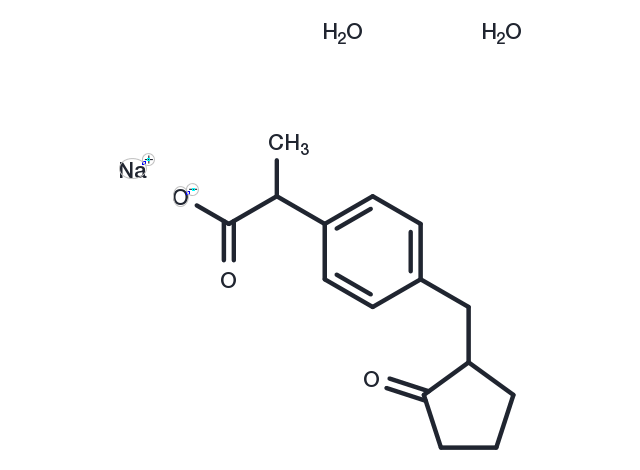Powder: -20°C for 3 years | In solvent: -80°C for 1 year


Loxoprofen sodium dihydrate is a non-steroidal, orally active anti-inflammatory agent that has analgesic and anti-pyretic properties. Loxoprofen sodium dihydrate exhibits antitumor activity which also can reduce atherosclerosis. Loxoprofen sodium dihydrate is a nonselective inhibitor of COX with IC 50 s of 6.5 and 13.5 μM for COX-1 and COX-2, respectively [1] [2] [3] [4].

| Pack Size | Availability | Price/USD | Quantity |
|---|---|---|---|
| 25 mg | 6-8 weeks | $ 1,520.00 | |
| 50 mg | 6-8 weeks | $ 1,980.00 | |
| 100 mg | 6-8 weeks | $ 2,500.00 |
| Description | Loxoprofen sodium dihydrate is a non-steroidal, orally active anti-inflammatory agent that has analgesic and anti-pyretic properties. Loxoprofen sodium dihydrate exhibits antitumor activity which also can reduce atherosclerosis. Loxoprofen sodium dihydrate is a nonselective inhibitor of COX with IC 50 s of 6.5 and 13.5 μM for COX-1 and COX-2, respectively [1] [2] [3] [4]. |
| In vitro | Loxoprofen sodium dihydrate is an NSAID (non-steroidal anti-inflammatory drug) that functions as a nonselective cyclooxygenase (COX) inhibitor, demonstrating IC50 values of 6.5 μM for COX-1 and 13.5 μM for COX-2 in human whole blood assays. This prodrug is commonly utilized in research for addressing pain and inflammation associated with both chronic and acute conditions. Its effects are mediated through the formation of alcoholic metabolites by carbonyl reductase, resulting in active trans-LOX and inactive cis-LOX. Additionally, LOX sodium dihydrate can be metabolized into an inactive hydroxylated form (OH-LOXs) through the action of cytochrome P450 (CYP). |
| In vivo | Loxoprofen sodium dihydrate, administered at 4 mg/kg/day orally for either 1 or 8 weeks, effectively reduces atherosclerosis in ApoE -/- mice on a high-fat diet (0.2% cholesterol, 21% saturated fat) between 8 to 16 weeks of age by diminishing inflammation [3]. Similarly, a 60 μg/mL oral dose given daily for 24 days significantly suppresses tumor growth in C57BL/6 and BDF1 mice with LLC and KLN205 tumors, respectively, by inhibiting vascular endothelial growth factor (VEGF) [4]. The first animal model showcases inhibition of platelet thromboxane production and aggregation, alongside a reduction in atherosclerosis extent and suppression of prostaglandin E2, thromboxane B2, and prostacyclin production. In the second model involving 6-week-old male mice, loxoprofen sodium not only suppressed tumor growth and angiogenesis but also curtailed VEGF expression and hindered tubular formation in human umbilical vein endothelial cells (HUVECs), underlining its potential against inflammation-induced atherosclerosis and tumor proliferation. |
| Molecular Weight | 304.318 |
| Formula | C15H21NaO5 |
| CAS No. | 226721-96-6 |
Powder: -20°C for 3 years | In solvent: -80°C for 1 year
You can also refer to dose conversion for different animals. More
bottom
Please see Inhibitor Handling Instructions for more frequently ask questions. Topics include: how to prepare stock solutions, how to store products, and cautions on cell-based assays & animal experiments, etc.
Loxoprofen sodium (dihydrate) 226721-96-6 inhibitor inhibit
